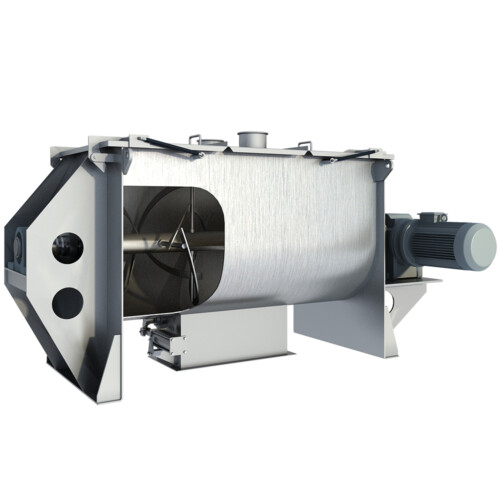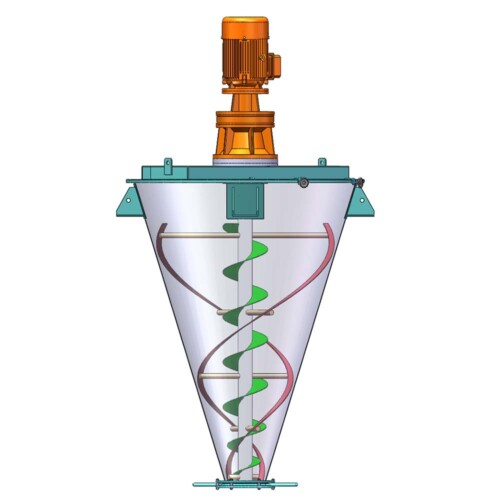Ask An Expert
Frequently Asked Questions
Yes, We can supply simple stand alone panels or automated PLC controlled systems. We normally install and test all controls on our mixers before they are shipped.
Yes, we normally test the mixers before they are shipped and mark out the wire need to connect on the control box.
We manufacture specialty mixing equipment for powder & bulk materials. Included are ribbon blender, plough mixer, conical screw mixer, twin shaft paddle mixer, V blender, double cone blender and other auxiliary equipment such as screw conveyor, quantitive auger filler.
We sell across the world, our cusotmers distribute 5 continents.
Share Us With Your Network
Mixture quality and how to measure it
This article provides useful background information for selecting a mixer by explaining what mixture quality is and how to take and analyze mixture samples to determine how well your product is mixed.
Are you in the market for a new mixer: ribbon blender, conical mixer, rotary drum mixer, double cone mixer, paddle mixer or plough mixer?, yet feel confused by the whole process of mixing? You’re not alone. A big source of this confusion is what many mixer manufacturers fail to tell you: They tend to talk about their mixers — their hardware — but not always about mixing itself.
For instance, many mixer manufacturers don’t define what makes a good mixture, what size samples to take for measuring mixture quality, or what method to use when analyzing the samples’ mixture quality. But you need to clearly define all three to be sure that your mixture meets your requirements and delivers the performance you need.
What’s a good mixture?
A dry bulk solids mixture is a mathematical ratio among the ingredients in the mixture. In a simple example, let’s say you have four particles in your hand — three salt particles and one grain of sand. Their ratio is 3-to-1, and the mixture is homogeneous. Of course, it would be nice if you could arrange all the particles in a much larger mixture into that same ratio. But a mixer is really a randomization device, and it can only randomize the particles in a large mixture to the best possible odds.
To improve these odds, the mixer’s mixing action should provide randomization by creating voids between particles that allow the particles to randomly roll together and by providing organized transportation for the particles by controlling the mixing speed and the void sizes. This mixing action produces a homogeneous mixture by overcoming the particles’ tendency to segregate by rolling apart.
How do I measure mixture quality?
Sample size and number of samples. You can measure your mixture’s quality by evaluating samples taken from the mixture. The first step is to decide how large a sample — and how many samples — you must take from the mixer.
In most applications, the sample should be the same size as the minimum amount of your mixture that will be used in final product form — for instance, a 200-milligram sample for a pharmaceutical mixture that will be formed into 200-milligram tablets, or a 1-ounce sample for a powdered drink mixture that will be filled into 1-ounce packets. If the final product will be used in more than one form, such as a powdered drink mixture that will be packaged both in 1-ounce packets and 48-ounce cans, the sample size should be the same as the smallest product form — in this case, 1 ounce.
A good rule of thumb is to take five samples from various areas of the mixer—for instance, for a horizontal ribbon blender, one sample should come from each corner and one from the middle. If the mixture is likely to segregate, you may want to take samples at the mixer discharge, as well.
Sample analysis. The second step is to determine how you’ll analyze the sample to measure mixture quality. Several mixture analysis methods are commonly used, and which is suitable depends on your product and mixing application. The most common methods are listed below:
Visual: While not very accurate, this method can be useful for determining if a mixture with differently colored (or other visually distinctive) ingredients is uniform throughout the mixing chamber. In this case, samples are taken from various areas of the mixing chamber and compared to see if they look the same. If the samples differ, the mixing isn’t uniform. With some samples, such as colored grout, wetting the sample may make it easier to spot color differences. A series of samples can also be taken at intervals during the mixing cycle to determine when the mixture’s color no longer changes.
Visual with an assist: This is another method that measures color to analyze how well a mixture has been mixed. The simplest version is for mixtures of differently colored ingredients. It requires comparing samples from various parts of the mixing chamber with a correctly mixed sample from a previous batch. A color difference between the new and old samples indicates that the new mixture isn’t uniform.
Another version of this method works well with mixtures with similarly colored ingredients. In this version, a colored powder is added to the ingredients in the mixing chamber. Then the mixer is started and, at regular intervals, the mixer is stopped to determine whether the colored powder has been fully mixed in. When it appears to be fully mixed, the mixing agitator is bumped or jogged, and the mixing chamber is checked for concentrations of color that indicate poor mixing.
Draw: This method is effective for mixtures that tend to form small lumps, such as food mixtures containing shortening and grouts containing fine pigments. It requires removing a small mixture sample, such as a teaspoonful, and dumping it on a sheet of paper. A broad blade, such as a spatula or putty knife, is pressed down on the sample and then pulled across the paper to draw the sample out as a thin layer on the paper. Any lumps — such as shortening or pigment — will show up as streaks, revealing that the mixture needs more mixing time and more shear. Draw test results for a masonry cement product are shown in Figure 2; the first sample (Figure 2a) was taken after mixing the cement in a mixer that didn’t apply shear, and the second sample (Figure 2b), which shows much better color development, was taken after mixing the product in a unit that applied shear.

Series of colored powder coating system used in visual analysis
Taste: This method is for analyzing the quality of food and drink product mixtures and simply requires an experienced tester to taste each sample.
Performance: This test evaluates a mixture by analyzing its performance in the product’s intended application. For instance, if a wall plaster compound sample runs rather than sticks after it’s applied to a wall surface, the binder hasn’t been properly dispersed in the mixture.

Using drawing method to determine mixture quality of masonry cement samples

A. After mixing without shear

B. After mixing with shear
Spectrograph: This is another method for measuring a mixture’s color quality. A spectrograph (which captures reflected light from material) or similar device can be used to determine a mixture sample’s color quality.
Statistical analyses of multiple samples: This method works best for mixtures of ingredients with different particle sizes that can be screened into fractions. First, each mixture sample is separated into fractions, often by sieve testing, and then each fraction is weighed to determine whether the amount of each ingredient in the sample is in correct proportion. The results for all the samples are statistically analyzed to determine the mixture quality.
There are also some useful variations of this method. In one, a small quantity of a tracer, a test powder with a particle size different than that of the mixture’s ingredients, is added before mixing begins to check the mixing action. (Often, a magnetic tracer is used, so that it can be removed from the finished mixture by a magnet at the mixer discharge.) Samples taken from the mixer are then analyzed by separating them into fractions and weighing the fractions to determine whether the proportions of ingredients — including the tracer — are correct. (One caution: With this method, the scale for weighing the sample fractions must have enough resolution to weigh the small quantity of tracer.)
Another variation of this method can be used with a mixture in which some ingredients react to acids and others don’t. In this test, a mixture sample is weighed, an acid is added to it to burn out the acid-reactive ingredients, then the sample is weighed again to determine the weight of the ingredients removed. The test is repeated with a few samples to calculate the mixing quality.
Preparing for the next step
Once you know the mixture quality your product requires, you’re ready to select a mixer that can produce the results you need. Be prepared to work closely with mixer manufacturers to find the right mixer type and size, with the right construction materials and finishes, to reliably mix your product.



















